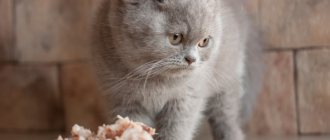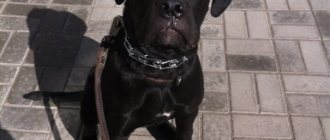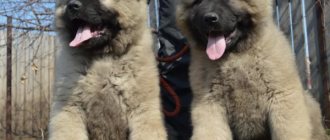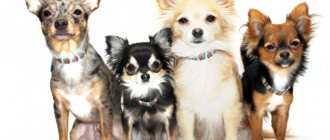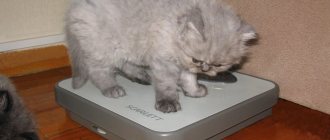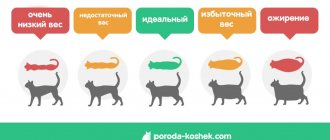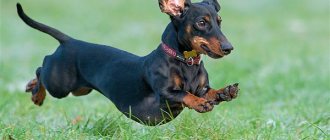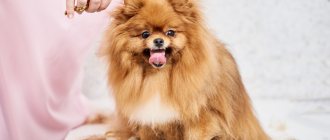Pomeranians are small, very beautiful and fluffy dogs that may appear somewhat larger due to their long and thick coat, which visually gives them additional volume.
It is very important for owners of such pets to know how much their Spitz weighs.
The size and weight of a dog is of considerable importance not only for an exhibition career, but also for the health of Pomeranians.
And, of course, puppy owners need to especially carefully monitor how their pet grows and develops.
What affects the weight and size of puppies?
The size of a Pomeranian puppy is influenced by factors such as:
- Genetic predisposition. As noted earlier, large individuals have large offspring, and vice versa.
- Diet. Overeating and undereating directly affect the baby's weight.
- Intense physical activity. With high activity, puppies' muscle mass increases and their body shape changes. Accordingly, the mass also increases.
- Vitamin consumption. If a baby does not receive the vitamins and minerals necessary for his age, he will begin to noticeably lag behind in development.
Parameters of newborn Spitz dogs
How much a Spitz weighs after birth depends on its type. The smallest weight in dogs of the doll, bear and fox type is about 85-90 g. In large representatives, for example, the German species, the birth weight is about 150-170 g.
Newborn animals have the following appearance:
- Instead of wool, their body is covered with thin and airy fluff, through which the delicate skin is visible.
- The head is quite large, still disproportionate in relation to the body.
- The body is short, the tummy is enlarged.
Additional Information. By the skin tone of a newborn Spitz, you can understand what color the coat of an adult dog will be.
2 weeks after birth, Spitz dogs begin to learn to stand up. Their eyes open, and the dogs even begin to recognize the people around them. Cuttles can hear only from the 18th day after birth. Pets begin to go to the toilet on their own after about 20-22 days, and from that moment on they no longer need constant maternal care. Spitz dogs begin to move actively only after the first month after birth.
What affects the height and weight of puppies
The generally accepted parameters at birth are arbitrary. Weight and height depend, first of all, on the individual characteristics of the animal. Some dogs grow faster, others gain weight slowly. These processes depend on a number of factors:
- Genetic predisposition. If a Spitz weighs more than expected at birth, it is necessary to study its pedigree. Perhaps he has large parents.
- Food. You gain weight faster on a natural diet. Animals fed commercial feed will gain weight according to generally accepted tables.
- Vitamins. If you give your pet strengthening vitamin and mineral complexes, its development will proceed somewhat faster.
- Degrees of physical activity. The more the dog walks, the faster and stronger the muscle corset is formed.
On a note! The only factor that can influence the final physical parameters of a pet is the formation of a muscle corset. The final size of the animal does not depend on other factors, and they cannot be changed.
A newborn Spitz is an incredibly cute and defenseless creature
To what age do Spitz grow?
The dynamics and growth rate of Pomeranian Spitz of different lines often differ. Some representatives grow to the adult norm by four to five months, others only by nine to ten. Female Pomeranians stop growing in height after their first heat. Thus, the average age to which Pomeranians grow is 6 months (six months). However, we are talking only about height growth. The weight continues to gain.
The final physiological formation is completed only by two to three years of life of the miniature Pomeranian Spitz.
Pomeranian Spitz weight by month
To clearly see how the weight of a Pomeranian Spitz changes by age, below is a table where the puppy’s body weight is indicated by month. Three columns indicate the dynamics of weight depending on the initial weight of the baby.
| Age of the orange | Puppy birth weight | ||
| From 70 to 95 g | From 100 to 125 g | From 130 to 140 g | |
| 1 month | 210-275 g | 325-370 g | 460-490 g |
| 2 months | 320-460 g | 550-620 g | 680-770 g |
| 3 months | 460-690 g | 800-900 g | 1-1.15 kg |
| 4 months | 600-800 g | 1-1.1 kg | 1.3-1.5 kg |
| 5 months | 700 gr. – 1.03 kg | 1.2-1.4 kg | 1.55-1.7 kg |
| 6 months | 770 g - 1.15 kg | 1.3-1.5 kg | 1.7-1.9 kg |
| 7 months | From 7 months of age, weight gain begins to slow down, and each representative of the Pomeranian breed occurs differently | ||
| 8 months | |||
| 9 months | From the age of 9 months, the Pomeranian Spitz grows even more slowly than before. On average, body weight gain during this time is 500 grams | ||
| 10 months | |||
| 11 months | |||
| 1 year | 1.3-1.6 kg | 1.7-1.9 kg | 2.1-2.3 kg |
Appearance
The body of Pomeranians is crispy and strong. But, undoubtedly, their pride is their thick and fluffy coat, in which each hair is located virtually perpendicular to the body, thanks to the rich undercoat. Their “fur collar” on the neck, reminiscent of the mane of a little lion cub, looks especially attractive. A cute little face with a “fox” nose, round black eyes and a wide smile, constantly brings positivity to its owners. The luxurious bushy tail, curled into a ring and lying on the back, is also worthy of admiration. The high-standing small ears and fluffy pants of the hind legs are also touching.
From the age of eight months, the Spitz should have its adult fur. However, the fur can continue to grow until the age of three. The coat of this dog breed consists of two layers, the outer layer, with long and smooth hair, and the inner layer, which is denser, short and woolly. Thus, caring for the “coat” of an adult animal should be aimed at maintaining both layers in good condition, avoiding those products and brushes that can harm either of them.
Appearance of a toy type orange:
- The hair on the hind legs is thicker and longer, as well as on the chest and head;
- Small height - up to 22 cm, and weight about 3-3.5 kg;
- Strong physique;
- Variety of colors;
- The ears are triangular in shape, set high, and small in size;
- The nose is slightly snub, the chin is upturned;
- The eyes are set close to the bridge of the nose, as well as to the nose, and have a round shape.
Features characteristic of small dogs:
- They love to eat and, if their diet is not controlled, they can quickly gain excess weight;
- Spitz baby teeth usually have long roots, which delays their loss and slows down the growth of molars, so you should monitor this process and, if necessary, consult a veterinarian;
- Pomeranians suffer from early tooth loss.
- The process of pregnancy and childbirth is often difficult;
- Dogs are more susceptible to joint dislocations and ligament damage.
Deviations from the standard
Only the Fox-type Pomeranian meets the breed standard.
The Pomeranian belongs to a large group of breeds called Spitz-type dogs. They come in different sizes - large ones play the role of watchmen and shepherds, small ones have received a well-deserved reputation as decorative pets.
At dog shows, dogs are divided by coat color into light and dark. Dark colors include chestnut (brown), black, gray-blue (zonal gray). Dogs of light shades - white, sand, cream and the whole red-red range (red, bright red, ruby).
Whatever the color of the Pomeranian Spitz, the breed standard requires the animal to have dark claws, a dark nose and lips. And only white, cream and brown (red) dogs are allowed pigmentation of the lips and nose, corresponding to the general color of the fur coat.
According to the standard, the following are considered very serious defects:
- anatomical defects of heredity;
- an apple-shaped head or an overly flat skull;
- eye size larger than standard or lighter shade;
- noselobe of weak pigment;
- sudden, incorrect movements.
At dog shows, Pomeranians can be disqualified for the following faults:
- not overgrown crown by the required age;
- the presence of a snack or undershot;
- inversion of the lower or inversion of the upper eyelid;
- semi-erect ears;
- fearfulness or aggression of the dog;
- white spots in color, socks and ties.
- Males of any species should have two clearly developed testes, completely descended into the scrotum.
Either way, whether you go to shows or not, the Pomeranian is suitable for families who love traveling and hiking. It can serve as a great motivator for lonely people who are tired of lying on the couch. A playful and playful dog will bring joy and diversify the life of active owners. Adult Spitz dogs are active, playful, devoted dogs, and when properly trained, are non-aggressive and obedient.
How to correctly measure a dog's height?
To accurately measure the growth of oranges, two methods are used:
- The first is this: you need to place the pet on a table or other flat, hard surface. Take a treat and get his attention. It is necessary for your four-legged friend to stand in a show position. When this happens, take a measuring tape. You need to measure the length between the scruff of the animal and until the tape stops on the tabletop.
- The second method involves using a ruler. You will need a strong and fairly long ruler and a limiter that fits on it. You need to put the orange on the table and put a ruler next to it. Next, move the limiter to the level of the withers and record the readings.
Don't forget to record the readings in a notebook to monitor your pet's development.
Proper coat care
Small dog breeds: the smallest types
Mini Spitz must be combed thoroughly:
- break up tangles that often form behind the ears, paws and in the abdomen;
- lying on your side, comb the hair into strands parallel to the spine;
- then turn over and repeat the procedure (you need to use a wide-tooth comb);
- Use a massage brush to go over the fur against its growth.
Then you need to repeat all the steps for the tail and “pants” and you can start washing.
- Place the mini Spitz in the bath and wet the fur with warm water.
- Apply shampoo. The main thing is to use the product specifically for dogs and follow the instructions on the package.
- Massage the coat and rinse off the shampoo.
- Rinse the wool with a special conditioner. Thoroughly rinse off any remaining product.
After this, you need to dry the dog thoroughly with a hairdryer, gently lifting the fur and directing warm air under it.
Brush the Spitz again:
- back against the growth of the fur and then vice versa;
- chest from bottom to top, and then to the other side;
- pants from top to bottom;
- The tail must be in the direction of hair growth.
When difficulties arise during brushing and washing, it's time to cut your pet's hair.
Pomeranian Spitz growth by months
| Puppy age | Normal dog height |
| 2-3 months | At 2 or 2.5 months, puppies reach 15 to 19 cm in height. At 3 months - 20 cm on average. |
| 4-5 months | At 4 or 5 months, the puppy's height is usually 20-23 cm. |
| 6 months | The average height of a Pomeranian at 6 months is 22 cm. The largest possible height is 25 cm for a standard pet and 55 cm for a large representative of the breed. |
After six months, as a rule, oranges stop growing in height.
Size of different types of adult oranges
Mini
The mini-Spitz is the tiniest representative of the Pomeranian breed (it is also called dwarf or miniature Spitz). These fluffies look more like a plush toy than a real dog. The height of a mini Pomeranian Spitz at the withers is from 18 to 22 centimeters, and such a baby weighs no more than 3 kilograms. The maximum weight of a dwarf Spitz is 3.2 kilograms.
The size of dwarf spitz puppies is even smaller.
Small
These representatives of the Pomeranian breed are larger than the previous ones. Such dogs grow to a maximum of 27-29 centimeters, and their body weight is within ten kilograms.
Average
The average representatives of the breed are called Middle Spitz. These four-legged animals reach from 30 to 38 centimeters at the withers, and already weigh around 11 kilograms.
Large
And these are truly large Pomeranians, reaching a height of 55 centimeters. Their body weight often reaches 25-30 kilograms. Large representatives of the Pomeranian breed are called Wolfspitz and Keeshund. These are herding dogs that always have a uniform coat color. Large Wolfspitz puppies sometimes weigh 5 kg.
Brief history of origin and interesting facts
The breed has a rather interesting history - the Spitz descended from an ancient peaty dog that lived back in the Stone Age. According to the main version, the animals were bred in the Prussian province of Pomerania. The official history of the Spitz breed began in 1870. Then they adopted the first standard, and a year later they organized the Orange Club.
A few interesting facts will help you get to know this amazing breed better:
- A Pomeranian named Boo is the cutest dog in the world. He had a personal Facebook page that attracted millions of followers from all over the world. Unfortunately, Boo died in 2022 after living for 12 years.
- According to legend, the Pomeranian lived with Isaac Newton, who discovered the universal law of gravity. One day, a dog “stole” an entire year from the life of a scientist - he set fire to valuable manuscripts.
- Due to their decisive nature, representatives of the breed are often called little Napoleons.
- The breed became popular in 1888 after Queen Victoria fell in love with an Pomeranian while vacationing in Italy.
- Previously, only wealthy people could keep Pomeranians. Therefore, the breed has become a symbol of wealth and wealth.
Expert opinion
Leonid Rodin
Experienced dog breeder
Ask a Question
Riddle: “What unites Mozart, Chopin and Elvis Presley.” Answer: all of them at different times owned Pomeranian Spitz dogs and even dedicated musical works to them. In general, over the centuries of their life near people, Pomeranians have witnessed and participated in many interesting events. For example, the famous Michelangelo Buonarroti absolutely owned a small Spitz. Although now dog experts are arguing whether it was a Pomeranian dog or its Florentine counterpart. Of the 12 dogs on board the infamous Titanic, only three managed to survive - one Pekingese and two Pomeranians. The medieval theologian Martin Luther also had such a dog named Belferlane. The famous magician Harry Houdini also kept a Pomeranian. His dog's name was Charlie, and it was given to the American artist by someone from the Russian aristocracy during a tour in 1903.
Pomeranian does not reach normal weight: what to do
It all depends on how much the shortfall is. A lag of 5-10 percent from the norm is considered insignificant. This is not a deviation and does not indicate a disorder in the baby’s development. Possible reasons for such a lag are a light skeleton or individual dynamics of formation. It happens that a pet first grows in height, and only then gains weight. You need to focus on your pet’s well-being and behavior.
When the deviation from the norm is more than 10 percent, the owner is obliged to find out what is wrong. The approximate weight at three months is from 500 grams to 1.5 kilograms (depending on the baby’s weight at birth). The normal weight of a dog at 3 years old is from 1.4 to 3.1 kilograms. The exact value depends on the sex of the pet and its subspecies (miniature spitz, small, medium or large). At this age the animal is already fully formed.
If your Pomeranian does not meet normal parameters, you should consult a veterinarian. Possible reasons for the lag are as follows:
- Lack of calories. You need to reconsider your pet's diet. Also make sure that he receives exactly what his body requires at the appropriate age. It is also important to maintain a balance of vitamins and microelements.
- Past illness. If your pet suffered from a serious illness as a puppy, this can affect its current condition. A weak, sickly child at 1 year of age will most likely not meet normal developmental indicators.
Recommendations that can help your pet:
- if the dog previously ate dry granules, then you can try switching to food from another manufacturer;
- Buy a vitamin complex for your pet according to his age. Lack of vitamins and minerals directly affects the development of the animal;
- take your four-legged friend out into the fresh air more often and play active games with him;
- Ask the breeder about the dog's pedigree. Perhaps slow growth is a genetic trait.
Pros and cons of the breed
Before you buy a Pomeranian puppy, you should consider its pros and cons.
But despite its abilities and advantages, the Pomeranian Spitz breed still has disadvantages. Parenting will require some experience and skills. On the street, males like to sort things out, picking on larger relatives. To prevent your pet from getting into mischief at home, you need to take him for a lot of walks, so couch potatoes should not get a Spitz dog.
All the pros and cons of the Pomeranian are presented in the table.
| Advantages | Flaws |
| Compact dimensions | Tendency to dominate |
| Charming appearance | Barking for no reason |
| Developed intelligence | High activity |
| Devotion | cockiness |
| Lack of hunting instinct | Waywardness |
| Good attitude towards children and other pets | Specific coat care |
Pomeranians are the cutest decorative dogs that become excellent companions for active people: in the morning little paws will stomp around the house, and in the evenings there will be a loud bark when the dog greets family members returning from work. These brave and energetic pets will remain faithful to their owner throughout their lives.
